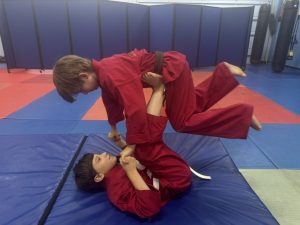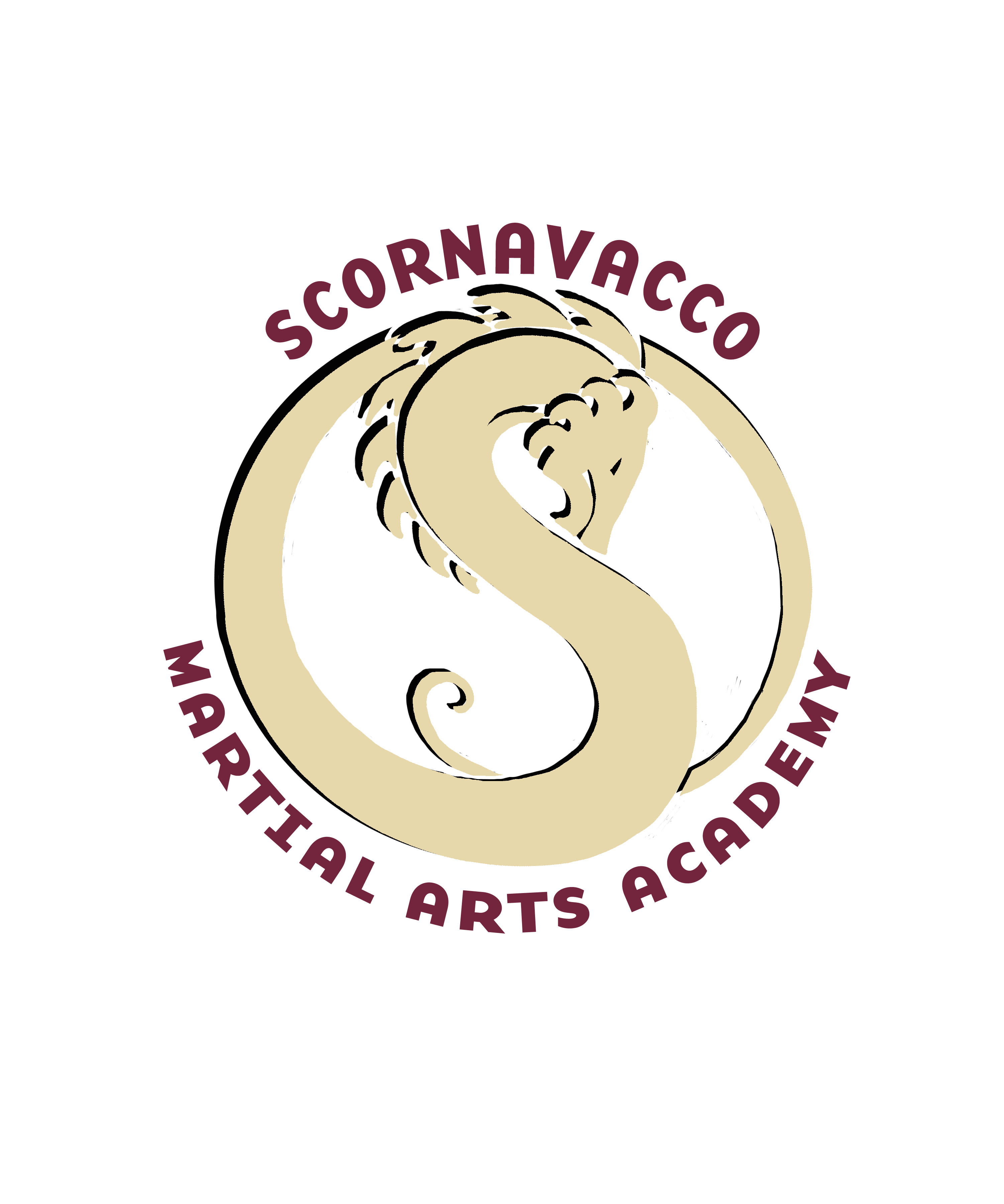 This month’s Powerful Word is TEAMWORK so I’d like to talk about how students use teamwork while they are practicing their base self-defense techniques.
This month’s Powerful Word is TEAMWORK so I’d like to talk about how students use teamwork while they are practicing their base self-defense techniques.
When students practice any self-defense technique they work in one of three phases of analysis: The Ideal Phase, The What-If Phase, and the Formulation Phase. Each phase has its own distinct training time and focus and student should always know which phase they are practicing at any given time in class.
The Ideal Phase of Practice
The Ideal Phase of learning a new technique is what we think of when we learn a new move. The situation is set up, i.e. what the attack is, and then what our response will be, the defensive moves.
When students are first introduced to the principle, think of this phase as,”when the bad guys does, X, I do, Y,” an everything goes according to plan.
While it’s critical to take the time to understand the presented principles, as soon as most students are introduced to a technique their brains IMMEDIATELY jump to,”What If…”, to the consternation of teachers everywhere.
Even now you may be wondering how teachers deal with all these “what if” questions, but just as in class, we first need to examine the Ideal Phase of Practice.
It’s in the Ideal Phase that students are training the proper movements into their motor memory so they can eventually do them at will, as needed, so they need the repetitions to learn effective and efficient movements.
The Ideal Phase also teaches students the desired consequences of their movements, e.g. if you strike the bad guy in the groin, he usually curls up and bends over.
Students must learn the likely effects of strikes and manipulations so they can later learn how to adjust if they miss or if the strikes do not have the intended consequences (addressed in the What If Phase).
What Does All This Mean for Teamwork in Training?
First off, it means that working in the Ideal Phase means that you both, attacker and defender, are cooperating, not competing, to ingrain the proper defensive principles and moves.
This simple fact is often lost on students when they play the role of the attacker/bully, and when they are called out, they often answer with, “I was just trying to make it realistic.”
Honoring the Strikes
When I was a student, the upper ranks would regularly remind us beginners to “honor the strikes” when we were the attackers.
They meant that we had to react as if the strike were real instead of just standing there like a stone statue.
Its called Stone Statue Syndrome
Upper ranks would walk us through the techniques, showing us how to react to each strike or how to fall safely when they did a takedown move — how to be a good partner.
We were taught a very clear rule, “move or we will make you move, honor the strike or we’ll really do it so you’ll move.”
I saw many a student shown how a technique actually worked, AND I also saw many a student for the last time after that particular lesson.
I’d rather not have students go that route.
I think explaining the purpose of the Ideal Phase of Training is would be more beneficial to everyone involved.
How to Practice The Base Technique
The Ideal Techniques are examples of effective self-defense principles; the principles are contained in and taught by scenario and sequence.
For example, in the very first technique on the list, Delayed Sword, students learn the effect of an inward block on the radial nerve of the attacker’s arm, the pain it causes and how the arm moves as a result of being struck. Then, they learn the effect of a front snap kick to the groin, bending over in pain at the least. Finally, they learn that because the attacker bent over, he is vulnerable to the chop to the side of the neck.
To learn these bodily responses, the attacker needs to take a crash course in acting.
Just like being in a Kung Fu movie, the attacker must respond to each strike so the defender can train both her targeting and her eyesight to note what effect the strikes should have.
What Can Go Wrong
If the attacker stands there with his arm out, frozen with Stone Statue Syndrome, not reacting to the strikes, then the defender inadvertently learns poor body mechanics.
Recall, the reaction you’re looking for from the groin strike is for the attacker to bend over, bringing his head down to your level, if you are smaller than he is, and possibly ending the encounter.
The power from the chop comes from a principle called Marriage of Gravity, from dropping all your bodyweight as you land from the kick to lend force to the chop to the neck and, ideally, knocking the attacker to the ground.
What is all-too-common is for students to drop their bodyweight, landing after the kick, but chopping UP to the neck on an attacker who hasn’t bent over, thus splitting their force and delivering a substantially weaker chop that likely will not be effective as it could be.
They hit the target, but their body is all out of position.
“It Doesn’t Work, and I’m No Good”
When students are in a learning mode and working with an uncooperative, even adversarial partner, they can suffer a severe blow to their self-confidence.
Imagine practicing something brand-new, for the first few times, and your partner makes sure you cannot even complete the sequence one time correctly.
With that kind of failure rate, can you blame anyone for wanting to give up in futility?
The attacker may feel like he’s helping, but he’s actually undermining his classmates learning process.
The Proper Role of the Attacker
In the Ideal Phase, the proper role of the attacker is partner and coach; the attacker should be helping the defender learn the correct application of a technique, not stopping them from successfully practicing it.
I can prevent anyone from doing the techniques correctly, yet I get down and let even our youngest students learn and apply the principles.
Do I ham it up for the 4 year olds? Yes, but they have fun learning the moves and practicing their targeting and control.
Do I mess them up? Yes, but only later, after they have internalized the movements, and in consciously constructive progressions that increase their skills.
Where Teamwork Comes Into Play
Instead of seeing the Ideal Phase as a sparring match or trying to make it a real confrontation between belligerents, when students see this phase of practice as cooperating with each other to be able to perform a technique so well that they cannot get it wrong, learning will take a quantum leap.
An attentive attacker will tell their partner when he’s making a mistake performing the base technique, rather than trying to thwart him performing the move.
Again, using myself as an example, you may notice me grabbing a student or tapping them on the head if their hands aren’t where they are supposed to be or dropping their covering hand.
Incidentally, when I was a student, if we dropped our covering hand even while doing the Ideal Technique, our partners would smack us, and if we left our groin open then we would get a quick kick to the cup.
These corrective strikes were automatic, painful, and highly effective at teaching us to keep our guards up and maintain correct position.
Now, I just lightly tap students as a reminder, which works just as well without all the bruises.
As an attacker I am cueing my partner and marking all the times when she is performing the Ideal Technique correctly.
This immediate physical feedback is invaluable as a learning principle.
Adopt a Cooperative Mindset for Best Results
The Ideal Phase is the first phase of training that builds your skills so you can adjust, adapt, and create to deal with unexpected moves and un-cooperative attackers in later phases of training, the What-If and Formulation Phases.
The proper mindset in the Ideal Phase is that you are your partner are working together so both of you learn to execute and perform as close to perfectly as you can. Both of you are learning to internalize the correct principles of movement, as a team, in this Ideal Phase.
Keep in mind which phase of training you are in and act appropriately for you best results.
